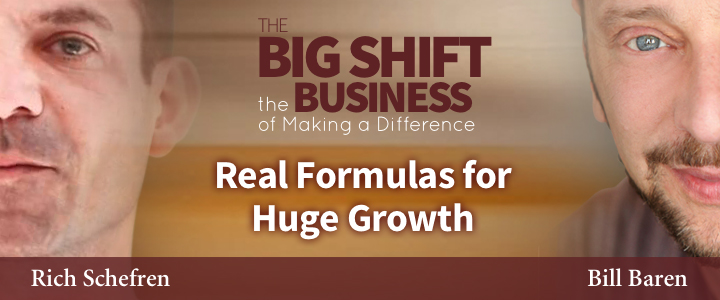If you had 4 more hours a day, what would you do with it? Entrepreneur, and founder of Strategic Profits, Rich Schefren, is all about maximizing your productivity, so you can spend less time working and more time doing the things you love.
The Real Productivity Secrets of a $10 Million Dollar Man with Rich Schefren | Ep. 06
Are you overlooking these 7 areas in your business?
Have you ever had this experience?
You learn a new word that you seem to have never heard of before, then, all of a sudden you start hearing and seeing that word everywhere.
Is the word being used more now that you’ve learned it?
Or,
Are you simply noticing it more because you’ve increased your possibilities by learning a new word?
When you open your attention to new things –> you increase your possibilities
When you’re stuck, it simply means that you’ve gotten into a rut of looking at the same things over and over again.
When you widen the range of what you pay attention to and then begin to change your actions accordingly, you shift. You get unstuck.
I call this “The Perception Principle.”
The perception principle is at the heart of why certain business owners stagnate or fail, and why others achieve success and create businesses that allow them to have financial freedom.
When you put your attention on “what works” in successful businesses, (including your own), you expand the scope of what you notice, learn and apply from what works, your business grows, your confidence soars, and your stress disappears.
Heres a list of areas that I find most business owners need to pay extra attention to:
- Your Audience – Knowing your audience and their needs and being able to articulate it
- Your Promise to Your Audience – Knowing what you’re promising your audience that they are actually willing to invest into
- Your Business Model – Figuring out the optimal way to set up the packages, offerings, and money flow in your business
- Your Marketing Flow – Understanding and optimizing the entire flow of how you attract and retain clients
- Your Team – Continually finding ways for you to do what you love, and let others take care of the rest
- Your Systems – Creating ways to get great results EVERY time (no more needing to constantly reinventing the wheel)
- Your Self – Total commitment to mastery in your areas of expertise including knowing yourself and getting better at being YOU
It’s not always easy to notice NEW POSSIBILITIES in each of these areas. And it certainly is not easy to commit to devoting time and energy to working ON your business in this way. Yet, the more you pay attention, and the more you can see your business with new eyes, the more your business expands to include new opportunities for increased revenue, better teams, greater partnerships and making more of a difference.
So let me know in the comments below – what is one area that needs more attention in your business? How can the perception principle help you focus on this area?
It’s Time To Fire Your Inner Perfectionist
I’ve got a wish.
I wish I could erase a word from your vocabulary. That word is perfection.
I know I am being dramatic here and it’s not really the word I want to erase, but I do want to erase the baggage that comes along with it.
When were attached to perfection:
- We spend a lot of time learning, and not much time implementing
- We procrastinate and procrastinate
- We spend too much time making it just right (and its still not perfect anyway!)
Heres the thing – whatever you’re doing will never be “perfect” until you try it out in real life with real people.
So heres my favorite motto: Imperfect action is better than no action.
Taking lots of imperfect action is what gets us new clients and new business.
I want to share a success story to inspire you to imperfect action.
Last month I was teaching the art of mastering enrolling conversations on a coaching call. I gave a participant a basic script for what to say in a sales conversation.
Instead of waiting months to get the script perfect and after almost “wimping out in the last moment,” she leapt into imperfect action right away and used the script with a prospective client. She stayed open and relied on her curiosity to get connected to her prospect. And by the end of the conversation, it was her prospect who asked if she had any packages she could offer her!
YES, this imperfect conversation turned into her client committing to working with her for the next 5 months. This imperfect action not only resulted in a long-term client, it also renewed her confidence in her business and her ability to enroll other prospects into her business.
Here are a few lessons for enrolling new clients and overcoming your desire for perfection:
Imperfect Action Is Better Than No Action: Stop waiting for the perfect time, the perfect idea or the perfect package. Use what you have and “just do it”. You can always improve on what you have later but by if you don’t put it out there in the first place you’ll never make anything happen
“Perfection” Is Not A One Time Event – Its A Process of Trial and Error: Try something out (such as a sales conversation script), learn from every time you use it, and make an improvement every time.
Be Honest: Honesty is always the best policy. During enrolling conversations don’t fret about following the right steps or losing the prospect. Be in your element, show genuine interest in your prospect and trust your instincts. When you are honest and passionate about who you are and what you do the rest will fall into place
Celebrate All Victories: By trying to be perfect all the time, we forget the small things we accomplish. Instead of just focusing on the things she forgot to do, I asked my client to celebrate the fact that her client ASKED for her services. What a great success!
ARE YOU READY? LET ME KNOW BELOW IN THE COMMENTS
If you’re a perfectionist and my ode to imperfect action inspired you, I’d like to ask you to share an imperfect action you’re willing to take in the next 7 days in the comments below.
“The Ultimate Time Mastery Technique”

What would you do if you could:
– eliminate the distractions and interruptions that are stealing your time and energy?
– say NO to low-priority tasks you shouldnt be doing?
Heres the SINGLE most powerful technique Ive discovered for getting started with reducing the time wasters in your business (which could be stealing anywhere from 50% to 80% of your time!).
DOWNLOAD The Ultimate Time Mastery Technique (PDF)
Are you ready to take the challenge, and use this for 3 days?
(If not, perhaps this could be what is keeping the time wasters in your day.)
I guarantee if you use this resource (instructions are inside) for 3 days, the way you think about time in your business will be transformed.
Its transformed my business and that of many of my clients.
And when you are ready to transform the way you’re using your time, join us at the The Big Shift Experience. Were going to show you how you can use all of the time you can be saving to:
=> work with clients you love
=> develop higher value products and program
=> partner with a whole new group of big-vision positive-thinking business owners
=> create a business model that works for you
=> double your income goal! (if you were on my 5 Big Shifts teleseminar, you know what I’m talking about)
Click here to learn more about The Big Shift Experience
Let me know your questions, insights – and your results (!!) in the comments below.
Constraint Driven Creativity
I usually give myself an hour to read blogs and write my own posts Monday through Thursday.
I have two different types of days of blogging:
1. I feel no pressure. I settle into the hour, read and allow whatever comes out of the time to naturally evolve. I enjoy my time. I am often happy with the result.
2. I begin the hour already worried that 1 hour is simply not enough time to read my favorite blogs and create a post worthy of my own inner critic. I feel rushed and often produce very little that I can even contemplate posting to my blog.
I am now in minute 21 of my hour. I am still feeling the pressure. My limiting belief is that I can’t get out of this pressure in this sitting. My desire is to simply write what is and allow myself to snap out of this mode.
Yes, our relationship with our constraints is the secret doorway to unlimited creativity. As that relationship grows, matures and becomes effortless, so enters our creativity.
Kathy Sierra has a take on it:
“What if you needed to build a powerful web app, but you had only ten hours a week for programming? What if you wanted to write a novel, but you had to do it in 30 days? What if you wanted to create a computer game, but you had only 48 hours? What if you had to write, shoot, and edit a short film in 24 hours? Constraints can be your enemy, but when it comes to creative breakthroughs, they can be your best friend.
Constraint-driven creativity is not just about inspiring (or forcing) creativity, it’s also about getting something done. How many of us keep planning to get around to writing that book… once we’ve got some free time? How many projects stay on the back burner forever because we just can’t seem to make it happen?”
We can look at our constraints as the walls of our prison cells or we can look at our constraints as simply borders of our canvas. So let’s pick up our brushes and let’s freely paint within the borders of constraints.
Yes, you can write that book in 45 days.
Yes, you can create this website for $5000.
Yes, you can build this widget with lighter materials.
Yes, you can run a successful business while working 30 hours per week.
What constraints do you have in this project?
What will help you feel the freedom in the constraints not despite them?
This is what Jack White of White Stripes has to say about it (from Tom Guariello’s book — Work Different: Design For The Rest of Us)
“A lot about the White Stripes is about constriction and keeping us boxed in. Being extremely stripped down to the most minimal components, mostly revolving around the number 3. You see that [we use] three colors: red, white and black. But also vocal, guitar and drums, or vocal, piano and drums; and, keeping ourselves limited. I think there’s more creativity where there’s less opportunity. Instead of trying to bring more musicians into the band or more tracks when we record or more time spent in the studio, it’s best to explore the creativity with limited means. You get more out of it; something more interesting happens.”
(40 minutes to complete this post from start to finish)
Stop whacha doin’

Ask yourself this question a few times per day and stop doing what’s not important.
This post is inspired by Seth Godin.






